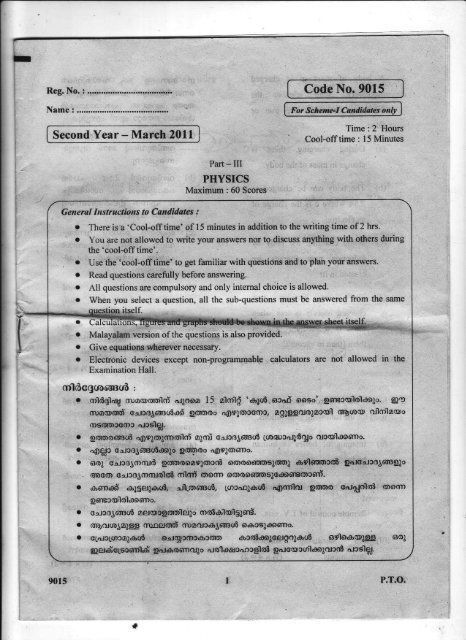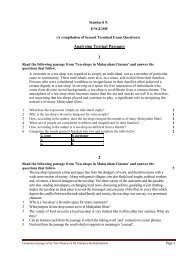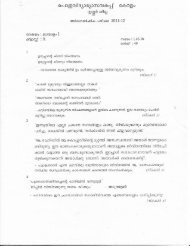Physics Plus Two.pdf - model question papers
Physics Plus Two.pdf - model question papers
Physics Plus Two.pdf - model question papers
You also want an ePaper? Increase the reach of your titles
YUMPU automatically turns print PDFs into web optimized ePapers that Google loves.
i<br />
Second Year - March 2011<br />
Code No.9015<br />
For Schena-I Candidates only<br />
Time : 2 Hours<br />
Cool-off time : l5 Minutes<br />
Pafi - III<br />
PHYSICS<br />
Maximum : 60 Scores<br />
Generul lttstruLtions to Candidates :<br />
o There is a 'Cool-offtime' of l5 minutes in addition to the \rriting time of2 hrs.<br />
. You are not allowed to write your answers nor to discuss anlthing with others during<br />
the'cool-offtime'.<br />
o Use the 'cool-offtime' to get familiar with <strong>question</strong>s and to plan your answers.<br />
. llead <strong>question</strong>s carefull) before answering.<br />
. All <strong>question</strong>s are compulsory and only intemal choice is allowed<br />
. When you select a <strong>question</strong>, all the sub-<strong>question</strong>s must be answered from the same<br />
itself.<br />
. Ualcula<br />
o Malayalam version ofthe <strong>question</strong>s is also provided.<br />
. Cive equations wherev€r necessaiy.<br />
. Electronic devices except non-programmable calculatorsare not allowed in the<br />
Examination Hall.<br />
rnldcqgoeantrE<br />
'<br />
. rtdqlq m>ocooroiloi<br />
"4ooo 15 ol.rnd 'eloa, aco.d ooso' g6rEcoil(oldolo. @"9<br />
fiuoo(rNoi corcoJ@BoEod goooo o{)g}o')cc(T,c, og}ggololocao,il orE
l. A body of mass m is charged lr<br />
negatively. State whether th€<br />
following statements are tnrc or<br />
false.<br />
(s)<br />
During charging' there is<br />
change in mass of the body.<br />
(b) The bodY can be charged to<br />
2.5 e where e is the charge of<br />
an clecuon.<br />
(c) While charging the bodY bY<br />
induction new charges are<br />
created in it.<br />
(d) The force between two<br />
charged objects is less when<br />
thsre is a medium between<br />
them lthan in vacuum]<br />
(% x 4--2')<br />
m o9fiu)gg ool ol(r\j(oloflo(f'<br />
oo@g1ci csrgco:t dcde' o,lgl(m)<br />
o,Coq oloaol(m LoJfiU(oc'xno'oA<br />
ooollccoc o(ocgs ooctt ooel(o16.<br />
(a) dodd o.rqlaoucuo<br />
(r|d(o)oilooe ocad olJloJcm)od5)crDl<br />
@) ocnirolojlcl 2.5 e<br />
'lc6€{<br />
oa,cs)@ocoi<br />
(ruc(r)l6o)o'<br />
(e gela;cLsc5rr'loaa<br />
"6cmrd'<br />
dcdd GrO6nJ.)<br />
(c) claoemo od,c6rE 'xfi$'olojloo,lc{dd<br />
oalgloclcoa<br />
d{(oilo) dc{Eslaqo ctuJ'qil<br />
doodslcnl.<br />
(d)<br />
dcdtetgg<br />
ot(r$o)l@oet4olso)1oi<br />
ocojoo 9o6rcdlon<br />
(o,ool<br />
o5rrg<br />
6roJ<br />
a,lo.rlc(otoil@olo. IsDl(nJ@@jle{ggo'ilo.n<br />
cocold'}ildl<br />
(vz x 4=2)<br />
2.<br />
Name the electomagnetlc waves<br />
used for the following applications'<br />
2.<br />
o)cog 6locol(m Cdolao|o.)CD@Boidd<br />
gdrc@cuildolcD oooloJ)@&cooto'<br />
(o)oo('@Bglos oolooe)(!tlo''<br />
(a) lmaging of bones in human<br />
bodY.<br />
(b) Mobile Phone communication'<br />
(c) Remote contol ofT.V sets'<br />
(d)<br />
orrl.orj oool.ooriloel GD((un}<br />
o,g]os lilL(')o o{)s)dofm(dtrD'<br />
(c)<br />
(b) oocoo5Tdd c"oc6ni olcdototcoitdloaoo|oild.<br />
51.ojl. oaDgld,giloel olcocs<br />
d,616c!scalegil(d<br />
(d) For sterilizing<br />
instrumenis<br />
9015<br />
surgical<br />
(Y' t 4 =2)<br />
(d) (r\)6s1€od goro,q6m6sBoi<br />
(o.5tn) ojlold(ooc€ol(mldild<br />
l%x4=2)
, 3, Consider the logic aircuit uslllg 3.<br />
NOR gates given below :<br />
NOR c(,r)glo,ui O;la(ocutd<br />
g5rccd6rloi5lgg (o)gos o,c5rDlfi)<br />
aerc€slid au6@,Jt5 6tono'leotra'.<br />
B<br />
(a) Wdlt the truth table for<br />
circuit,<br />
(b) Identify the logic operation<br />
which this circuit is<br />
performing. O)<br />
th€<br />
(a) p.e m>66yffloofl L')OP<br />
(r) os5DIqA 609](u'14, o)<br />
(b)<br />
eO.c
5. 100 c)<br />
5.<br />
100 cl<br />
(a) Find the equivalent resistance<br />
ofthe above circlrit<br />
(l%)<br />
(a) @c nD6.6$!ilooa (r\)^oer<br />
LoloilGC)c(Do 66r|3loi5loolo''<br />
(rv, )<br />
(b)<br />
Determine the current through<br />
(b)<br />
75 O Ldojlcocoolo)lejlos@]gp<br />
oo.tloj)(' L"lolcdo<br />
(l'lLol(o)<br />
the 75 C) resistance (r%) (r% |<br />
o,c6mla,<br />
o, Television broadcast is done bY<br />
space wave mode ofpropagation'<br />
(a) What is the difference<br />
.<br />
between sky wave and space<br />
\\ave modes ofPropagatiL'n I (l)<br />
(b) A TV transmission antenna is<br />
81 m tall. tlow much seNice<br />
area can it cover if<br />
the<br />
receiving antenna is at the<br />
$ound level ?(Radius<br />
ofearth<br />
is 6400 kml<br />
Ql<br />
7. sometimes when we switch off the<br />
etectrical equiPments. a spark is<br />
seen within lhe switch This is<br />
explained on the basis of<br />
' electromagneticinduction'<br />
(a) What is self induction ? O)<br />
6. oseiloil.oioA lo)oJo@Bglos<br />
mic"-rmi Goloi<br />
o'l(oilcoltelc6n; (T)gorol(rt(d.<br />
(a) mioo@, aoroi [orca'eoi5m<br />
@1(oil(o)lo auc"ial coloii<br />
Ldca,lud6m o'loiol" r6tDzlel)BA<br />
d-\ro,,\ctruo ^O<br />
l)<br />
(b) ool sl ol'1. Lolcaai6i5m<br />
ajroogl.r,dad 8l olgd<br />
goroo]od.<br />
LdjcaItloldl])o<br />
Ldlcdgdl5mo<br />
eicjoc;tlc ?<br />
lcloil(oJ)os csrg(oo 6400 htu] (2)<br />
aDna,o:l@6rl(m GDall(r) (oo<br />
(rilo*ild Grgo6me;loi Ldrcasl-<br />
".rem ogcflrneo] 'rJ?Jc d0Lo)<br />
oilcg1old6lqo|onoi @,]D<br />
7. ooattoJl(d, gdla'o6rn@r3oa ocnd<br />
o,lgfu cruoo)orli'ieicCcra<br />
aDn4il(r,lgEloE'nioJc66d d'conco)6n{<br />
oooloj}(D a'ccota'<br />
ci"-roem
(b) Cunent in a circuit falls from<br />
5,A to 0A in 0.1S. If an<br />
average emf of 200 V<br />
is<br />
induc€d, determine the self<br />
inductance ofthe circuit O)<br />
(b)<br />
6l(0l rudo,Jl5loer oooroJlot<br />
Lololcdo ot'ltctlo, sA-co:l(d<br />
nari 0A GDaoit 0 l S-oE<br />
a,]o{o}ff}. @oc0o@1200 V<br />
@,"Oo."O"n. cLdo6mo o'19-<br />
oqlsyrn)oo100,103, mr60'J151-<br />
oo{ o.ruoa"-d Pdiru,qoicti<br />
er6rBlojlslool@,.<br />
(l)<br />
8. The captain of a ship sailing in the<br />
Atlantic Ocean has to tlavel in the<br />
north direction to rsach the nearest<br />
port. He finds that the magnetic<br />
declination of the present position<br />
of the ship is 5'22'East.<br />
8.<br />
(oodelcalld m)olt6olojloi m)ooroll6ol(m<br />
oo] o,Ceiloel d,Jcol"gd<br />
oloc5s]oo (o]oo]5-!od "Oolocoi<br />
osao; cltrooooed m)6Dlo1c@o6rBortr6ri.<br />
a,gd Podc{rA nfloi@ol(rr)<br />
(rDaerotonooe @,cdojla, rutdgilc(r.,.eicl<br />
5"22' (o,1e€6Y) cro6rd.<br />
(a) What is meant bY magnetic<br />
d€clioalion ? O)<br />
(b) The captain has a magnetlc<br />
compass needle with him BY<br />
how much angle and in which<br />
direction should he deviate his<br />
ship from the north direction<br />
pointed bY the magnetlc<br />
compass needle to reach the<br />
port? O)<br />
(a)<br />
(b)<br />
6,ccon6, oljl$lc(n,s\a o{)(rr,.Joi<br />
"O@i ?<br />
eJ<br />
@,cooaDl,j 96n9. ootc5s}(dro<br />
9. R€ntya makes the following oircuit 9.<br />
to mdasure the emf of a cell<br />
4ilo1€olcY, aDAd,Jls g6tRc€6tlml.<br />
'<br />
She says that the voltm€ter reading<br />
will give the emfofthe cell.<br />
(a) The PhYsics teacher says thal<br />
it is not Possible to measure<br />
the emf of the cell in this uaY'<br />
Jusd$ this stalem€ttl.<br />
(b) Explain with a circuit diagram<br />
tfffirE$idd to measure the emf<br />
(l)<br />
of a cell with a Potentiometer<br />
if<br />
You are given another<br />
standord cell (whose e m f is<br />
kno\tt) (3)<br />
OR<br />
9. The th€rmat v€locity of electron $<br />
about 106 n/s and drift velocity is<br />
about I 0-3 m-/s<br />
(a) what is meant bY &ift<br />
veloctry /<br />
(b) Obtain a reldi€|r between drift<br />
0)<br />
velocity and clectrie cunent (3)<br />
9.<br />
€Qao flDd6,J1:iloer aolcdgalg{i<br />
ol(lDl6ld cocol(o166tlo gq.ooro..Ood'<br />
6{)fiij ool aloo)l(Irrl.<br />
(a)<br />
(gorDlc"jtr6, !8o<br />
"olauldad<br />
o'loril(Dld o(ll)Cibq<br />
fS."Oo."O.d. 6{81.'idl@cd<br />
10. ln inteference and diffractiol of<br />
light, dark and b ght bands are seen<br />
on th€ screen.<br />
(a) Do these Phenomena violate<br />
thc law of conseryation of<br />
energY ? Explain. (r v)<br />
(b) ln an interference Pattem, the<br />
ratio of maximum intensity to<br />
minimum intensitY is 36 : 9'<br />
l'ind the ratio of amplitudes<br />
inreNities of the two<br />
interfeling waves.<br />
10.<br />
tdec@ooilonl @oliodooaAaJ,<br />
oltt oc6'9iai ot]56itrtao L"ioil@cdDeBEild<br />
PQ@)5rc(o)lo (olo,csoocooco)(o)loco)<br />
6DlcoicDld,oi fi|j161-<br />
(IioA @'c6modslml.<br />
(a)<br />
@.e t Jotk3c(rl)eueiloE godee<br />
dDooo,9i6lY, crilo)oo el""eil-<br />
€oodslff)lc6rr3c<br />
d,o1l6ole,.<br />
? ojl0o61-<br />
(r%')<br />
(b) ool Pnfldo"nocdau orag-<br />
6nnd @,lslco Ldld'c@<br />
o,lL(ll(o(o)lo, 61C,51010.) lol6c@<br />
oii'.uroco;o o)ooilellgE<br />
oacn;.lcoro 36:9 (sro5tt'<br />
(r)s(oot](m<br />
@alaodooaAau<br />
@ooo6ltBglos<br />
(6ro.o)oila'gr<br />
os@lo (d)lLojoteglos@lo<br />
6618)-il5l<br />
ll.<br />
A series LCR AC circuit has<br />
great practical importance' It is used<br />
for tuning radio, TV, wireless sets<br />
etc.<br />
(a) Obtain an exPression for<br />
current in a series LCR AC<br />
circuit using Phasor diaglam (3)<br />
1 l. 5'0l (rl)'lo1r|J LCR dO mt'<br />
(rudaJl5loj<br />
olgoo@qt6o<br />
L.rcc@cqjle, LoJc(r)c(nJo 96r€'<br />
Gro(i Gooiloaoc, s'l.ojl., olaordoerad<br />
ofiug)6,o4 @l966B1roolo1'd<br />
s51en;loolai 9"Jco)c(/il€o)(ml'<br />
(a) c6.(r\)d o!.ot('o golcao)cq'l4<br />
61col cu1ol('d LCR<br />
'O'ml'<br />
(rDda,JlSloel oo(|lRJl(d'<br />
L.lojc.o<br />
(o'l(ol(odod 6l'0l<br />
aDoolca,Joeo5lEotol6<br />
(3)<br />
9015<br />
(b) Under what condition, this<br />
circuit is used for tuning ? (1)<br />
(b) p'e (rl)dd,Jls sjl6rrn5srtoi<br />
g.lococqjld6rcdi d'glo)lmoi<br />
.O6qoocn? (1)<br />
P.T.O.
12. You are sitting in a r6om in vihich a<br />
'<br />
13.<br />
uniform magnetic field B exists. At<br />
the cente of the room a charged<br />
particle is suddenly projected<br />
horizontally and il stans circular<br />
motion in the horizontal plane.<br />
(a) What should be the direction<br />
of the magnetic field for this<br />
to happen ? (l)<br />
(b) Will there be a change in<br />
kinetic energy of the Particle<br />
due to this circular motion ?<br />
Why ?<br />
(l)<br />
(c) A cyclotron uses a magnetlc<br />
.field and an electric lield to<br />
increase the . energy of a<br />
charged particle. Describe its<br />
construction and working. (3)<br />
To emit a ftee electron from a metal<br />
surface a minimum amount of<br />
energy must tre supplied.<br />
(a) This energy is called -<br />
(b)<br />
9015<br />
(7')<br />
State three methods to suPPlY<br />
this energy to the ftee<br />
elecfton..<br />
(l%)<br />
(c) When light of ftequencY<br />
7.21 x l0la Hz is incident on a<br />
metal surface, the ma-rdmum<br />
. speed of the ejected electrons<br />
is 6 x 105 rn/s. Calculate the<br />
threshold frequencY for the<br />
m€tal. (3)<br />
12. n{'a'16,5otoc(o) 6l(0] ' a'cooil6,<br />
o6rrDero B (rnelcril(fldoJ(m o(ol<br />
oJ.ilo.jld c,l5sBon pokol(m].<br />
oJdaolos o(Djr3c(.r)oro,l dfi;<br />
oo)<br />
ooorr'jJ.o a,6rDo "{O(oo))<br />
Olod A@l<br />
oilo('all(r) otel(oorloE 6o6gfJJ(m].<br />
(a) @6!BorD ruoe.rll@ol(m(oil.d<br />
@,cooild, o5rnDeiGroioae l31@<br />
o4;CrOrCOr'lOlOOemo ? (1)<br />
O) gq.ID (116(610,]9 de|(rto od,cfira<br />
oooi€Jlo, @,6m('tdrlool<br />
U)oilc4,cdesoto'lci ocgo<br />
mJoGOfldOlCOC ?<br />
"oclo}l<br />
oo,c6tg ? (1)<br />
(c) 6'o1 oo(Ddcgcalsc6rrild<br />
ooorRJlo, 66m@IJg)Os 9'9(&<br />
eeco oxiathil€ocd oo.lBlJo<br />
o6rnDelor)o 6,cooil$ 06lTllr_<br />
el(ulo 9dlcoc('ocsJ(dld))(ml.<br />
ooal)dcgccLs'tmloal tets_<br />
(rr(o)lo LdjolTEotD(r)o{o oilooo"l-<br />
6,o:ldola,. (3)<br />
13. 6r(0) cetc"o t"lorelo|oilo8 (rilcrtJ<br />
perdcLsc5rDla,og m)@Lc.Docdocoa<br />
5t(ol dluojlo' dl(ol6w'@<br />
9.01aego aqfoal(roJ0c6ri.<br />
(a) po g.cde-eotdnci<br />
oO(mJ olocol(rD]<br />
(b) gc g|'deeo o.e,cslatl.rDotct<br />
(c)<br />
(v,')<br />
3 ocdgl6sBqa t"J(rdo)c.ril')ola,.(l%)<br />
7.21 x l0!a Hz rorqoSoroil-<br />
!o)gg LdJ6'c@o o@l ceJcdo<br />
LoJoeioroiloi "loil.oolcallcq8<br />
o{oorotl olo}.m PeldcLsc6ml-<br />
6,glos 6Joocoj(|t GOJ(')OT<br />
6 x 105 n/s croosmoilo8,<br />
eeJc4ooDtootr oL('cdelc0irui<br />
Grooljooil6,6m€ocdol6,. (3)<br />
I<br />
I
14. Bohn proposed a new <strong>model</strong> ofatom<br />
to ovelcome a problem of<br />
Rutherford's atom <strong>model</strong>.<br />
(a) Which specific problem of the<br />
Rutherford <strong>model</strong> was<br />
attempted to be solved bY<br />
Boh<strong>model</strong> ? O)<br />
(b) What are the basic Poshiates<br />
ofBoh <strong>model</strong> ? . (3)<br />
(c)<br />
The radius of the inner most<br />
electron orbit of a hYdrogen<br />
alom is 5.3 x l0-ll m. What<br />
are the radii of the n = 2 and<br />
n=3orbits? A)<br />
14. ot|o6o"oe{Acui dogo oocoleiloer<br />
ool t rodoo<br />
"lo1ldoo1€olff)oil(r)l-.<br />
coJ6rE'loc6rd c6rtcd Goco!(d<br />
ni16aQ('oll€oodgd.<br />
(a) olLoric"ocdori cocnejloel<br />
(orsd.rroc6nl c6rucd<br />
"6d<br />
ooc(DeiloE doloooil€ooai<br />
(b)<br />
(c)<br />
6no14d ? O)<br />
c5l)lcla cocu)eiloeJ @DgkrDnca)<br />
Ldlocdm5Erioi d$o.6t$co ? (3)<br />
oog oo"olor.raaa Gqg(oonoel<br />
"ogo)o<br />
eeclerleg @eidotsc6ni<br />
6rc66Dildlool (drgoo<br />
5,3 x l0-rr m crgsr#. n=2 9o<br />
n = 3 @lo GO{o ocd6nJlgl@,-<br />
g;os orEoo ? A)<br />
"61ro<br />
15. A capacitor is a<br />
901s<br />
storing charges as well as energy. It<br />
is bas€d ort a propertY called<br />
capacltance.<br />
(a) write the sl unit of<br />
(b)<br />
(c)<br />
aapacitance and deflne it.<br />
You are given two capacito$<br />
of 2 pF and 3 pF. What are<br />
the maximum and minimum<br />
values of capacitance that can<br />
be obtained by combidng<br />
(f)<br />
them ? (2)<br />
Obtain an expr€ssion for the<br />
electrostatic energy stored in a<br />
capacitor. (3)<br />
c(ocdcg€gorlo cuocol6ol.m<br />
6r(0l gorcutaoc6nJ 4dcmtgd. @d<br />
odcaulgaiad oofiD ('l5mo(oo<br />
trqL@otd td.jol6otoil€otcml.<br />
(a) o'dcnDlgoisuloae SI Ql6rrtd<br />
cro(oilo(r) (rndqf<br />
"Oeloil<br />
(f)<br />
"jl@olo,.<br />
O) crn5msad6l 2 pF Oo 3 PF 9o<br />
edecrDlgaid 999 o6rE<br />
d"dcmtgo)o,0o o,(rrtlolldol(ml.<br />
pQoro(o o,lsloq&<br />
6o)c(nrcoa 6,15co{o o8go{o<br />
orerlo,lo<br />
d4gorJo<br />
oelololoco d,dcru18(#<br />
mlAoi do(ot ? (2)<br />
(c)<br />
5lo) d,dccDlgcnd cruoreolg!-<br />
@1€6rl(m ooorlJJootcti@eo|otd<br />
cloorcoJo@,o6rBolo)ld,. (3)<br />
P.T.O.<br />
a
16. A lens of a particular focal length is<br />
made from a given glass slab bY<br />
adjusting radii of curvatue. The<br />
.formula<br />
used in this case is lens<br />
maker's formula.<br />
(a) write lens maker's formula. (1)<br />
(b)<br />
Derive lens maker's formula<br />
assuming formula for<br />
refraction at a sPherical<br />
surface. (3)<br />
(c) Is it possible for a given lens<br />
to act as a converging lens in<br />
one medium and a diverging<br />
lens in another medium ?<br />
Why ?<br />
(d) Compare the focal length ofa<br />
given converging lens for blue<br />
light with that using red light.<br />
Are they equal or different ?<br />
why ?<br />
OR<br />
16. A microscope is a device used to<br />
9015<br />
obtain magnified images of small<br />
objects.<br />
(l)<br />
(a) Draw a labelled raY diagrarn<br />
(l)<br />
of a comPound micruscoPe<br />
forming an image at the near<br />
point ofthe eye.<br />
@,<br />
10<br />
16, rocrriloloo;
(b) Obtain an expression for the<br />
magnification Produced bY a<br />
compound microscope. (2)<br />
(b) nol auocol€ro m.1a's8o-<br />
Bdsolrn P6nec,ooJclT)<br />
(grg.udoD(Do<br />
a,5lrq}ojl5ldol(m(6td<br />
srol m)oocojo rr'ldaDco6rDo<br />
oerglo' Q)<br />
(c) If<br />
the objqctive l€ns is<br />
immersed in a transparent oil,<br />
what will haPpen to the<br />
resolving power of<br />
the<br />
microscope ? IliPlain. (2)<br />
(c)<br />
cruge'doodcrol




